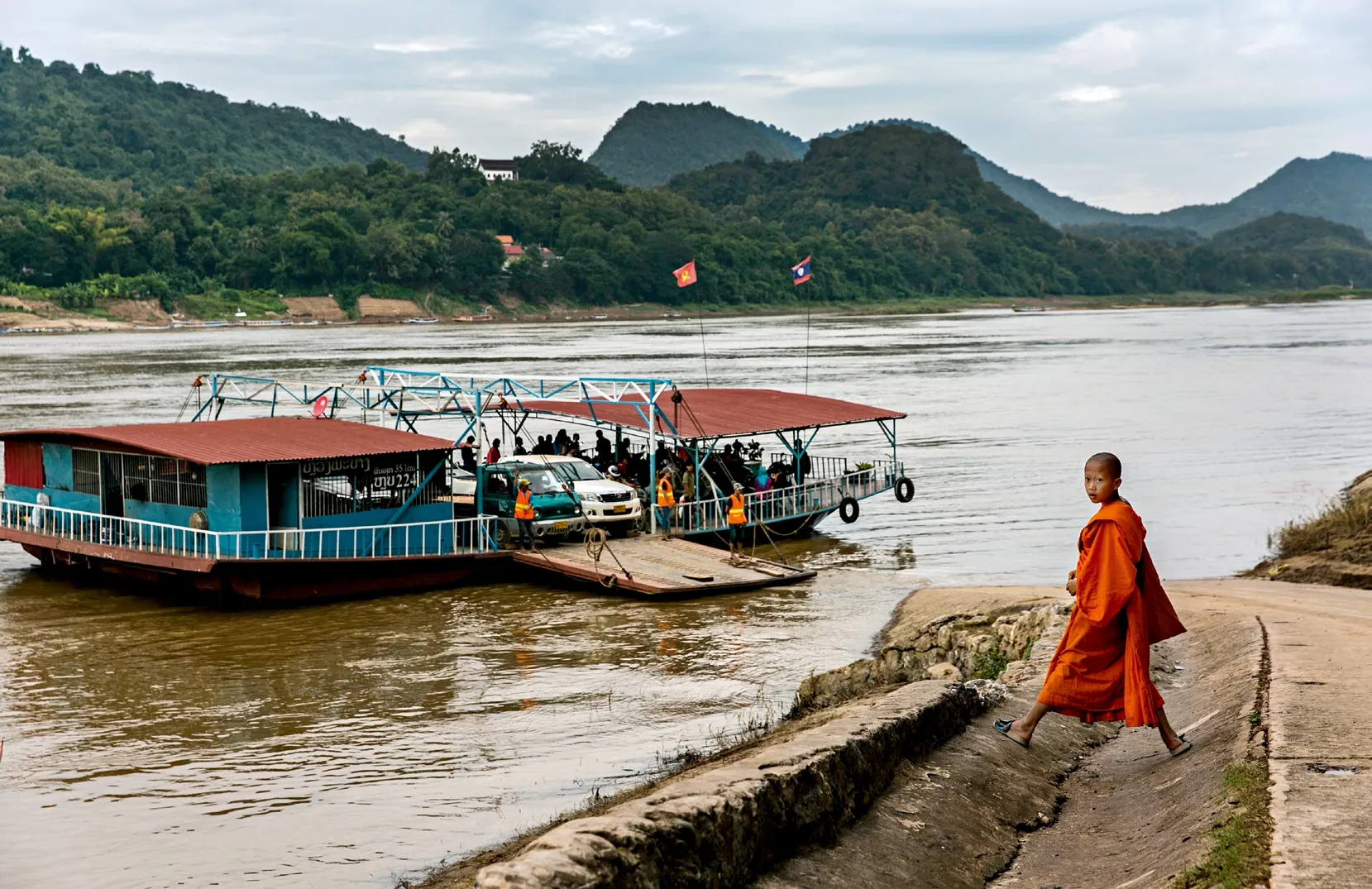ENCHANTING LUANG PRABANG Linking Laos to china
By Qin Bin

A child jumps into a river in a village outside Luang Prabang.
417 kilometers
160 kilometers per hour
On December 25, 2016, the groundbreakin g ceremony of China-Laos Railway (CLR) was held in Muang Xai, Luang Prabang Province.The CLR starts from Mohan-Boten land border crossings in northern Laos and passes by Luang Namtha, Oudomxay and Luang Prabang to reach Vientiane Province and Vientiane Capital. The 417-kilometer railway is expected to open in 2021 and carry both passengers and freight at a speed of 160 kilometers per hour.
In a country where Hinayana Buddhism is the core belief, locals’religious life and daily life have long been intertwined.
E xquisite and ancient Luang Prabang is the capital city of Luang Prabang Province in northern Laos. The city is situated at the meeting of the Nam Khan and the Mekong rivers in an area of less than 10 square kilometers on the left bank of the Mekong River.It has a flat terrain and is surrounded by mountains and rivers.
Luang Prabang boasts a wealth of Buddhist culture highlighted by numerous temples and monks in the small urban area. The glittering temple eaves, exotic French colonial buildings and diverse customs of different ethnic groups all serve as draws for tourists from all over the world. Records show nearly 700 time-honored buildings with preserved status in the city. Luang Prabang was listed as a UNESCO World Heritage Site in December 1995.Alms Ceremony
Luang Prabang is extraordinarily tranquil in the morning mist. Locals get up early to start making glutinous rice for the alms ceremony in the dim light. Most days in the city begin with the scent of glutinous rice.
Monks from each temple in Luang Prabang walk barefoot in their orange Kasayas as they form a long line to beg for alms in the street. Believers line up along the street to hand out glutinous rice and fruit to the monks successively. Among the givers are seniors as well as teenagers, who lack shoes like the monks. They kneel on mats and use two hands to place food into the monks’ bowls.When the bowl is full, the monk takes only a portion of the food for himself and dumps the rest into a large basket for other poor people.
The ritual of daily giving is performed by ordinary people throughout the city. Temples in Luang Prabang don’t cook for themselves, so all food consumed by the monks must be obtained through begging for alms.
Only footsteps can be heard throughout the alms ceremony,and everyone remains calm and quiet. The ceremony is not complete until the last monk passes by. In a country where Hinayana Buddhism is the core belief, locals’ religious life and daily life have long been intertwined.

People sit back and relax by a river at sunset.

A ferry pier in Luang Prabang. Ferries shuttle back and forth between the banks of the Mekong River.
The alms ceremony, an activity that has been passed down for a thousand years,remains a great start for the day.
New Business Opportunities
Most tourist attractions in Luang Prabang are concentrated in the old town on a peninsula reaching to the Nam Khan River from the Mekong River, and most restaurants operate along the Mekong River and the Nam Khan River. Phu Si Mountain, at the heart of the city, is a glaring landmark offering a panoramic view of the city from its peak.
Of the many temples in Luang Prabang, Wat Xieng Thong is perhaps most famous for its magnificent hall,exquisite pagodas and carvings and gorgeous inlay.
Traditional handicrafts such as gold and silver ornaments,silk and pottery produced in Luang Prabang are wellknown in China. The city is an important traffic junction in northern Laos and a distribution hub for medicinal herbs, timber and grain.
Highway 13 which runs across Laos passes by Luang Prabang.It has an extension connecting to China’s National Highway 213, making it an important international road connecting China, Laos and Thailand and a key artery for Laotian commodities transportation.
Today, more and more Chinese tourists drive from Xishuangbanna, Yunnan Province, to Luang Prabang to take in the scenery along the way and experience exotic cultures.
Laos is an important participant in the Belt and Road Initiative, and a number of relevant projects have been launched in the country.On December 25, 2016, the groundbreaking ceremony of China-Laos Railway (CLR)was held in Muang Xai, Luang Prabang Province. The CLR starts from Mohan-Boten land border crossings in northern Laos and passes by Luang Namtha, Oudomxay and Luang Prabang to reach Vientiane Province and Vientiane Capital.The 417-kilometer railway is expected to open in 2021 and carry both passengers and freight at a speed of 160 kilometers per hour.

Dolls sold in a shop.
CLR is the first overseas railway project mainly invested, constructed and operated by China and directly connects to China’s railway network. It adopts Chinese technologies and standards and uses Chinese equipment.The completion of CLR will promote cooperation in agriculture, industry, tourism,trade and investment between China and Laos and advance ties between China and the ASEAN Free Trade Area (AFTA).
Dreams of Ordinary People

Locals fish at the confluence of the Mekong and Nam Khan rivers.
Construction of the railway and bolstered tourism development are luring more and more Chinese people to Luang Prabang. At age 25,Chinese entrepreneur Mr.Wang operates a two-story hotel in the new part of Luang Prabang. Most of his guests hail from China, some of whom are tourists, but the majority are employees of Chinese companies implementing construction projects in Laos.
The rate for Wang’s hotel is around US$17 per night,and his rooms fill up almost every night. “Our hotel rooms maintain a high performance cost ratio, and the business pressure is not as intense as in China,” Wang admits. “When the railway begins service, we will never suffer a shortage of guests.”
Mr. Chen from China’s Hunan Province runs a Sichuan-cuisine restaurant near Wang’s hotel. After the lunch rush, Chen relaxed by sipping baijiu (Chinese liquor)brought from China as five local waiters took a lunch break.
“The pace of life here is pretty slow, and the competitive pressure of restaurants is also not as bad,”he reveals. “Employees are paid according to local standards,and the price of vegetables is the same as in China. Laos is an agricultural country, so the food is natural. Most of my guests are from China, and locals also eat here quite often.”
Chen has been living in Laos for 10 years. He once was a chef earning 8,000 yuan (US$1,160)monthly but gave up life in the fast lane to start his own business. He bought a piece of land for cheap on which he built a restaurant to operate.
In the old town where the tourists are concentrated,Mr. Hou runs another busy Chinese restaurant. Hou plans to rent the house next door to acquire more space to expand his business, but he’s been tied up with planning his son’s wedding to a Laotian girl. Hou went back and forth between multiple government agencies to cover every procedure for his son’s transnational marriage.
A Jun, a Chinese-Laotian businessman, operates a crafts shop in a market in Luang Prabang that sells all kinds of wooden bracelets, woodcut sculptures and Chinese herbal medicines. Every morning,a steady stream of tourists visits the market, making it his busiest time of day. Lately, he has been posting news about cooperation between China and Laos on social networking apps.
Before Chinese President Xi Jinping paid a state visit to Laos in 2017, CCTV (China Central Television) News app posted a piece of news titled “President Xi Jinping Publishes a Signed Article in Lao Media.” A Jun commented: “Cooperation between China and Laos is driving the development of Laos. We hope for Laos to continue evolving into the future.”

